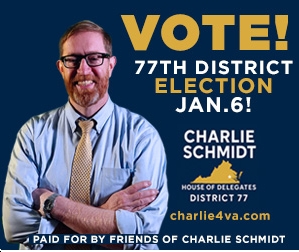by Anthony Flaccavento — a farmer, author and bottom-up economy consultant from Abingdon, Virginia, and the two time Democratic Candidate for Congress in Virginia’s 9th district. Cross-posted from The Stansbury Forum.
“Jesus was asked what it meant to love your neighbor, and He replied by telling about a man who had been beaten and robbed on a lonely road. Without help he’d die—but the first two men who came across him ignored him. A third man, however, stopped, tended his wounds, and then took him to an inn and paid for his care. Although he was a foreigner, he alone was the true neighbor.” – Billy Graham
“I love the best in you. You love the best in me.” – Jane Siberry (from, “You Will Walk in Good Company”)
The first time I ever heard of “Pizzagate” was the week after Trump’s election in 2016. A pleasant, mild-mannered fellow who’d been an occasional customer of ours at the Abingdon Farmers Market was telling me about his belief that Trump would be good for small businesses and family farmers. I disagreed and expressed my grave concerns about Trump’s character. “Well, I could never have voted for Hillary Clinton. She is so dishonest, and she’s done such terrible things,” he said.
And then he told me about Pizzagate. If you missed that four years ago, it was the online conspiracy theory that Clinton and other powerful Democrats were holding child sex slaves in a secret basement chamber below Comet Ping Pong, a popular pizzeria in Washington, DC. As this young man delineated the details of this conspiracy, I was incredulous. “Where are you getting this?”, I asked. “Oh, it’s all over. It’s all over the internet.” I suggested that he might want to double check the sources behind such extraordinary claims. He was pretty sure it was all true, though he allowed that “It does sound rather preposterous”. “Maybe that’s a good reason to doubt it”, I said.
Pizzagate was in many ways the precursor to QAnon, the now much more widely held conspiracy theory that scores of Democrats, liberals and Hollywood elites are running an international, Satanic pedophilia ring, which also likely includes draining the blood of children and even cannibalism. Just three months ago, a QAnon offshoot held that Wayfair, the on-line furnishings store, was using coded language and exorbitant prices to cover their own trafficking in child sex slaves.
According to a recent poll, more than half of Republicans believe that QAnon is either true or partially true. For many, according to Religion News Service reporter, Katelyn Beaty, it is “taking on the power of a new religion.” While conspiracy theories are embraced by people across the political spectrum, multiple studies have found that they are more intense and more enduring on the right than on the left. In a 2020 analysis done by Sander van der Linden and colleagues, they found conspiracy theories embraced more strongly by conservatives than by liberals, and significantly more strongly among extreme conservatives than extreme liberals (1). Joanne M. Miller and her colleagues investigated the factors behind embrace of conspiracy theories, focusing on two variables: mistrust of the government and those in power; and the level of consumption of political news and content. Their study demonstrated that for both liberals and conservatives, low levels of trust in government inclined people to believe in conspiracy theories. However, for conservatives, increased levels of information (“knowledge”) exacerbated conspiratorial thinking, while for liberals it diminished it (2).
From QAnon, to “Sandy Hook was a hoax,” nearly all of the most prevalent conspiracy theories of the past ten years have emerged and nested on the right. They’ve energized thousands, even millions of conservatives and accentuated partisanship and ever more extreme polarization.
Liberals tend instinctively to dismiss people who believe in conspiracies like QAnon as uneducated fools, closed-minded dupes. But that’s off-base. As Steven M. Smallpage and his colleagues show in their 2017 study, “partisan conspiracy theories are not merely markers of psychological quirks, alienation, or psychopathology, but rather of shared core associations—similar to issue ownership (Petrocik, 1996)—with a major political party. Conspiracy theories clearly communicate partisan content and therefore could be used as strategic signals. The content embedded in conspiracy theories signals to partisans who the sender is, who the villain is, and what the potential danger is. This demonstrates the potential for conspiracy theories to generate collective action.” (3)
For those on the right, conspiracy theories are both an end and a means, a way of galvanizing the base in common purpose – fighting a global cabal of satanic pedophiles, for instance – while intensifying the shared hatred of liberals, Democrats and progressives. While most of the theories and the most extreme vitriol is directed at liberal elites, it is increasingly common on the ground, as well. Rumors that “antifa” set the fires that ravaged southwestern Oregon in September, spread like, well, wildfire, even as local sheriffs’ departments made categorical denials and pleaded for people to stop spreading them. Similar rumors that “antifa” or Black Lives Matter agitators are “coming for us” have sparked fear and spawned gatherings of heavily armed, nearly all-white vigilante defenders in many small towns across the country.
In short, right-wing conspiracy theories are the front edge of a much more widely held loathing of liberals that permeates most major conservative organizations and a large swath of the Republican Party. When Bill Walton, president of the conservative Council for National Policy said, in August, “This is a spiritual battle we are in. This is good versus evil”, he was articulating what more and more on the right truly believe.
Trump, of course, is by far the most powerful and prolific purveyor of this hate. He is the standard bearer, but also the culmination of the constant din of dehumanization through which Glen Beck, Alex Jones, Sean Hannity, Ann Coulter and so many other prominent right wing pundits have been poisoning our society for a generation. They, along with Trump, have utterly changed the stakes for disagreement along political and cultural lines. They have turned “the other’=” – us – into dangerous, loathsome creatures to be vanquished at any cost. “This is good versus evil”, said Bill Walton, “and we have to do everything we can to win”.
In my little part of Appalachian Virginia, I find it hard to imagine that my neighbors fear and hate me for my known progressive beliefs. We still get along; we see one another around town; some of them buy our produce. But increasingly I fear that, while they may not hate me, a growing number may well hate my ilk. Myself and other progressives make good, local work a priority, whether it’s fixing up old community buildings, supporting our farmers markets or promoting local businesses. And at some level, I think this diminishes the mistrust and helps preclude the worst divisions. But as a nation, the rifts grow bigger by the day as does the intensity of the hate and the conviction of good vs evil. So, call this a foolish plea, a naïve request, but to neighbors near and far, across the political spectrum I ask: Can you love the best in us, if we commit to loving the best in you?
- Sander van der Linden, Costas Panagopoulos, Flavio Azevedo and John T. Jost, “The Paranoid Style in American Politics Revisited: An Ideological Asymmetry in Conspiratorial Thinking”, Political Psychology, June, 2020
- Joanne M. Miller, Kyle L. Saunders and Christina E. Farhart, “Conspiracy Endorsement as Motivated Reasoning: The Moderating Roles of Political Knowledge and Trust”, American Journal of Political Science, November, 2015.
- Steven M. Smallpage, Adam M. enders and Joseph E. Uscinski, “The partisan contours of conspiracy theory beliefs”, Research and Politics, October – December, 2017














